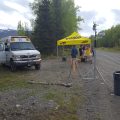Several hams in the local area had noticed form digital activity on 147.54 MHz over the past few months. It was a signal of great interest as it was very active and nobody seemed to recognize its signature. Ultimately, a DF hunt tracked it down to KL4C’s residence in South Anchorage. Chris was kind enough to fill us in as to what was going on and what he’s been up to. It turns out this was a Yaesu Fusion System C4FM digital voice signal. Chris provides the following summary to let folks know what’s up, and to maybe stir up a little interest in this new and interesting mode! You’ll also see that he mentions another C4FM signal active on 147.05 MHz that we identified. More on that later.
From Chris:
Here is a brief rundown on my operation in the 2M and 440 MHz. bands from my home QTH near Goldenview Middle School.
I have been fiddling with D-Star and C4FM for several years, mostly from low power hot spots inside my home (DV4 minis, RF Shark OpenSpots, DVAPs, etc.) About a year ago I placed a Yaesu DR1X repeater on the air, on a UHF pair coordinated by Mel (KL7GG). That machine was not networked, but was operated in Yaesu’s “Auto” mode, repeating either FM or C4FM, which ever appeared on the input. That repeater is on 444.3 +5, no tone.
With the UHF transmitter having some trouble, I placed a Yaesu FTM100 in service as a simplex node, connecting to the Yaesu Wires-X network via their HRI-200 interface. This simplex repeater links to the internet via the HRI-200 and a Windows computer.
In summary, the Wires-X network is an addressable series of “rooms,” like D-Star reflectors, and also direct access to repeaters and other stations. I typically have the system connected to the “America Link” room, which is the most active of the US-based rooms. Using a Yaesu Wires-X compatible radio the connection can be moved to another room/repeater/station. The Wires-X network has other functions (services) as well – numerous Wires-X websites and groups offer lots of info.
I moved the hotspot from 147.54, where I understand it may have been causing some problems to frequency-proximate IRLP nodes. My apologies for that – I have now sorted out the UHF feedline issue I had, so the C4FM simplex node is now on my 440 repeater output frequency – 444.3, no tone. As before, it is normally connected to the Americas Link room. Next step will be when I get the Yaesu repeater back online.In any event, I am always pleased to have others use the system. I will be sure that the setup allows calls other than mine to get to it.
Two last tidbits – I was able to hear C4FM traffic on 147.05. I am not certain of the setup, as it made voice announcements of the room to which it was connected – I have not seen that capability with my setup. That node was connected to another popular US room that is focused on Minnesota/Wisconsin (not limited to that, however.) Lastly, someone recently got my node to connect to a KL2? station/node – I was mobile at the time and didn’t catch the info before it disconnected.
That was the first time I had seen someone other than me redirect my node – intentional or not I was glad it worked!
I have included my contact info below, and will be happy to provide information and share what I have learned about C4FM.
Chris Brown
5273 Cape Seville Dr.
Anchorage, 99516
907/350-8212 (mobile)
907/264-7360 (office – AT&T)
cb777@att.net [1]
73,
Chris, KL4C
—————————————————————————————–
Thanks Chris for sharing all this! And for the rest of the folks out there, does anyone know the source of the C4FM on 147.05 MHz? DF efforts had shown this to be somewhere in the Boniface/Northern Lights/Patterson area, but we haven’t tracked it down yet. If you know what’s up, we’d love to hear about it to learn more. Digital voice is gaining popularity, and this is really something we need to explore in our area and as a club.
73,
Kent, KL5T


